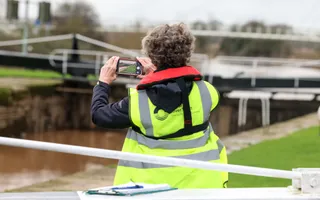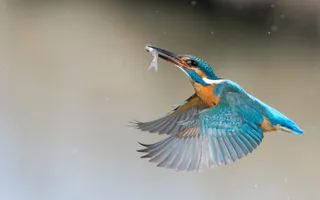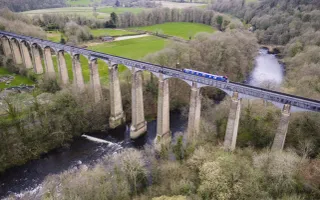Below are answers to some of your most frequently asked questions.
What is the current water resources position?
24 October 2025 update
Although most of our canal network has reopened and restrictions have lifted, navigation is still affected in some locations due to low water levels or related works. Water levels in many of our reservoirs remain low, but we’ve taken steps to open navigation where possible. Our teams are actively monitoring our water resource position, and all updates on closures or restrictions will be communicated through our notices and stoppages.
Where canals are open, either fully or with restrictions, we expect customers to move as normal, in line with our requirements for continuous cruisers.
Please visit our page dedicated to questions on continuous cruising if you have other queries.
Do I need to request an extended stay if I’m within a low-water stoppage area?
We are continuing to pause 14-day reminders in affected areas. However, if you are on a canal that is no longer closed, we expect customers to move as normal and will continue to issue 14-day reminders on open waterways.
If you believe you’ve received an overstay reminder in error, please email [email protected] and we’ll look into it.
I am a continuous cruiser and am worried about what will happen at my annual cruising review? Or, I am a continuous cruiser and am currently on a restricted 6-month licence. What will happen at the end of my licence?
If you have been unable to cruise and are in an area that is affected by closures or restrictions, please be assured that any period of reduced movement will not impact your licensing options in future. Please respect mooring time limits when navigation is possible to allow all boaters fair access to moorings, service facilities, and towns. For more information regarding our boat monitoring process please see How we monitor boat movement. Please also see our Continuous Cruiser FAQs.
How much notice will I get ahead of a navigation closure or restriction due to low water?
Where possible, we’ll give at least two weeks’ notice via our Stoppage system. However, weather conditions can change rapidly, and occasionally closures may need to happen with less notice. To ensure you don’t miss important information, you can use our Notices to view all closures, restrictions and advice notices. Filter by “Stoppage Reason” rather than “Type”, as some current restrictions are planned to become closures at a future date. All information will be within the notice.
What should I do if the canal I'm on is due to close soon?
Check the stoppage notice for local advice and updates. If you live on your boat, we’d recommend returning to your home mooring if you have one and it’s possible in the timeframe. If you haven’t got a home mooring or it’s too far away to reach before closures, move to somewhere you can access essential facilities. Please don’t moor on water points or block facilities as other boats will need to use them too.
We strongly encourage all boaters to start making plans now. This includes:
- Emptying waste tanks
- Filling up water and fuel tanks
- Stocking up on essential supplies
- Considering relocating your boat to areas closer to services or, if you have a home mooring, returning your boat to your marina/mooring
Can I still cruise within a stoppage area if I avoid using locks (e.g. moving along the same pound)?
Yes, you can move your boat within a pound, provided it is safe to do so. There may be exceptions, for example deep-draughted boats may not be able to move in low water.
What if I can’t access essential customer service facilities?
If a stoppage leaves you with no reasonable access to water points, refuse and recycling sites, Elsan, or pump-outs, please contact us. While we expect most customers to make their own arrangements where access remains possible, we will offer advice and, where necessary and feasible, provide support for those in genuine need, based on individual circumstances and local conditions. Contact Us.
Our Notices & Stoppages system includes both live updates on current restrictions and closures and planned restrictions based on water resource projections.
A map of the affected areas can be found by filtering by reason: ‘Low Water Levels’ and selecting ‘Map View’. We have recorded a short video to help you get the best out of the Notices & Stoppages system, which you can view below.
We also have a helpful webpage with instructions on how to receive stoppage notifications on your smartphone
I have a disability or other access need and am concerned about the impact a closure will have, who can help?
Please get in touch at the earliest opportunity and we’ll see what can be done to support you. If you or someone you know is struggling, our Welfare Team can provide signposting and support.
Reservoir works:
The Trust is investing many £millions carrying out essential maintenance on reservoirs to make sure they continue to comply with the stringent law and remain safe, in the face of a changing climate and more extremes of weather. The work will ensure the long-term integrity of the reservoirs and the vital water supply they provide to the canal network.
In some instances, the maintenance requires water levels to be temporarily ‘held down' meaning there will be less water than normal available for boating. In the north, following conversations with hire boat firms and other stakeholders, we are introducing shorter operating hours in several locations to conserve water for navigation. There is more information on our current reservoir works here.
We are asking boaters, with the help of volunteer lock keepers, to be even more careful than usual to conserve water. See the monthly summary of reservoir holdings in our national “reservoir watch” here.
Day-to-day water management
Where can I find out about the water resource situation?
The Trust's website is a great source of information on the latest water resource position and any boating advice/restrictions. Our water management team produces a monthly reservoir watch on the site, which gives details of reservoir holdings across the network. Or you can visit the stoppages page to subscribe to notifications in a particular area.
How can boaters help?
Saving water is a team effort and we all have a role to play. However boaters are by far the best partner we have in helping to save water and their support really is invaluable.
Boaters' top tips for helping to conserve water include:
- Share locks where possible and make the best use of the water available;
- Make sure paddles are fully closed once you've passed through a lock;
- Aim for minimal contact when navigating through locks by ensuring gates are fully open as you pass through. Pushing gates open using a boat can damage the gate lining, increasing its leakage.
- Please report any leaks by calling 0303 040 4040 or emailing via org.uk/contact-us
Marina owners, particularly those with hire fleets, can help by encouraging boaters to follow these simple tips.
Please only use the water point to fill up your water tank to use for drinking water and hygiene purposes. Please do not use the water point to wash your boat with a hose or jet washer.
We also need all canal users to be vigilant about vandalism, please call the police if you have any concerns or witness vandalism.
What is the potential ecological impact of low rainfall?
Careful management of our precious water resources is vital. We need to maintain a minimal level of flow in the canal to protect fish and other wildlife and prevent the water from becoming stagnant. Low reservoir and canal levels, coupled with higher temperatures in summer months, can cause problems such as algal blooms and low oxygen levels in the water. In extreme cases, we may intervene to save distressed fish with large scale fish rescues.
Why don't you fix all the leaks?
The majority of water lost from man-made canals is through leakage via the canal bed and banks. Much of today's current waterway navigation network consists of clay-lined canals which are more than 200 years old. These are not 100% watertight and it would be impractical to fix every leak. However, the Trust is committed to identifying and repairing any significant problems and carries out hundreds of large and small repairs every year.
Do restrictions simply concentrate the same lock usage (and hence water use) into a shorter period?
No, our experience shows that where we've implemented similar restrictions in the past, we've subsequently seen decreases in total lock usage. However, the water resource savings do vary across different canals and between years.
Why don't you operate pounds brimming with water as the longer pounds could operate as a reservoir?
The loss of water from a canal pound due to leakage and seepage is the largest component of water demand on a canal system. Loss rates are at their highest during the summer, when soil is dry and water tables are low. The leakiest part of the canal lining is the top 15 cm (6 inches), because it is continually wetted and dried. It is also subject to holes or cracks formed by burrowing animals and wave action from boat propellers. So increasing the operational level of a pound, especially in a drought, would greatly increase loss rates. During a drought, we actually aim to run pounds as low as operationally possible to reduce losses.
Why don't you dredge reservoirs to increase their capacity?
We have a rolling programme of surveys to monitor the capacity of our reservoirs and these show that generally, over a number of years, siltation hasn't been a significant problem. It is also generally accepted across the water industry that the removal of silt from reservoirs is considerably more expensive than creating new resources or reducing demand elsewhere. This cost means that reservoir dredging is very rarely cost-effective and, particularly so in this case given the results of our reservoir monitoring.
What are you doing to ensure water restrictions or stoppages aren't needed in the future?
As well as responding to unfolding droughts, we also take a more strategic approach to managing future water resources. Our water management team is responsible for assessing the resilience of water supply and advising the business on the potential impact of proposed canal developments (e.g. new marinas) and investment required to supplement water resources.
The Trust reserves the right to object to or decline canal development proposals on the basis that they may have an unacceptable impact on the existing water supply. Unfortunately, we can never give absolute assurances to our customers about having enough water to get through every drought, regardless of the extent, duration and severity but we will do whatever we can to keep as much of the network as possible open.





